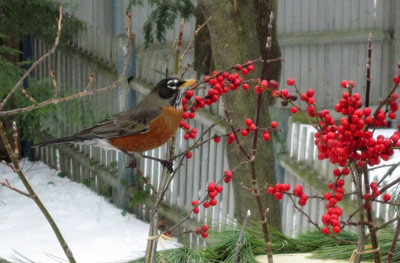Closer to Home
January 08, 2013 / The Volunteer Tree
There’s a volunteer tree on my deck. It lives in a large pot to which I transplanted it last year when it was starting to get pretty big. I call it a volunteer because that’s what my Mother used to call plants that found her garden and settled in it without asking.
My tree is called an Ash-Leaved Maple, or sometimes a Box Elder. A full-grown one, almost certainly its parent, lives next door. I’m a plant person (though not a horticulturist/gardener), and I have a lot of plant field guides, so I was able to find out the name of my young tree. It has leaves in pairs, opposite each other along its branches, so that’s one way I knew it was probably some kind of maple. Only four trees in New England, where I live, have opposite leaves: maple, ash, dogwood and horse chestnut. Most of the ash trees around here have died off because of an infection, so I was pretty sure it wasn’t an ash, even though its leaves are kind of ash-leaf shaped. And I know dogwoods and horse chestnuts, so I could rule those out.
Anyhow, my volunteer tree has been growing on my deck for about five years now, and it’s big enough to cast a little shade and is almost as tall as me. At first I didn’t pay much attention to it, but after it survived a couple of winters in its pot out there in the cold, I began to coddle it a bit, and it has rewarded me.

Even in winter, my tree rewards me. First, in the holiday season, I decorate the bare twigs of my tree (it’s too young yet to call them branches, I think). I affix sprays of bright red Winterberry that I buy at the local garden shop. Winterberry is sometimes called Christmas Berry, and it’s a kind of holly with fantastically RED berries on it. I use twist-ties to strap some fruitly Winterberry twigs onto my little maple, and lo! It looks as if it is bearing fruit itself. The great thing is, it seems this looks real enough to fruit-eating birds that they come and help themselves.  Quite a few times winter Robins have come, and over a period of a couple of days have stripped my maple tree of its holly fruit! There can’t be anything much prettier than a Robin in the snow eating bright red berries.
Quite a few times winter Robins have come, and over a period of a couple of days have stripped my maple tree of its holly fruit! There can’t be anything much prettier than a Robin in the snow eating bright red berries.
But even after the bird-attracting fruits are gone, my tree rewards me in a more profound way. For within its gray-brown buds, the green of spring lies hidden, as it does in all buds in winter. Gently peel away the bud scales that protect that which is within from drying wind and cold.  There you will find a tiny dot of green: next season’s baby leaves, formed in summer’s abundance. Safe within the bud scales, the embryonic leaves nestle, ready for the lengthening light of spring to trigger their swelling and bursting forth. Go ahead! Find a bud on tree or shrub, and open it up. There is spring in its renewal and hopefulness! What a gift!
There you will find a tiny dot of green: next season’s baby leaves, formed in summer’s abundance. Safe within the bud scales, the embryonic leaves nestle, ready for the lengthening light of spring to trigger their swelling and bursting forth. Go ahead! Find a bud on tree or shrub, and open it up. There is spring in its renewal and hopefulness! What a gift!
Tree flowers are in there, too. A neighbor has a Magnolia tree and with her permission I have opened Magnolia buds in winter, to find the folded pale green petals of the glorious flowers to come.
Lots of people think the buds form in springtime. But if you think about it, you can figure out that growing “expensive” things like leaves, with their complicated chemistry and all, would be too hard for the tree in winter or spring—not enough sunlight or liquid water to power the growth. So the tree does all of its growing in high summer, and just wraps those little leaves up in scales to help them make it through the winter.
The days are getting longer now, every day a tiny bit more light. I think I’ll go out and take a look at my volunteer tree now, see how it is doing, and maybe just open one bud to reassure me that spring will come and my tree will renew itself. I will keep you posted on my tree.